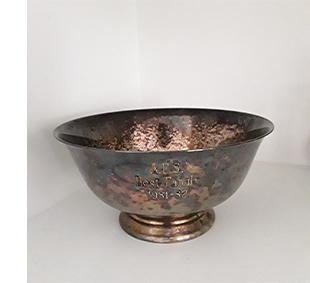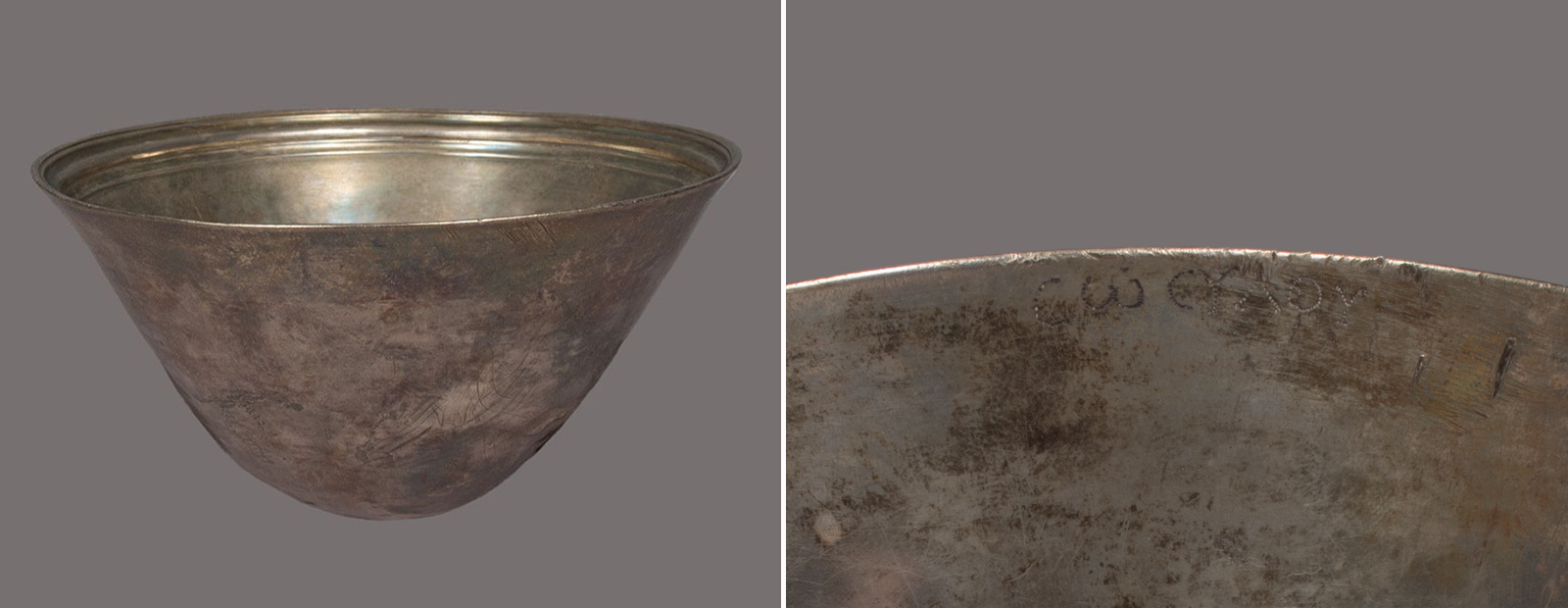With our present abundance of time at home, many of us are considering our accumulated material possessions. Whether tucked away in the attic or on display, silver is a material often found in the realm of treasured heirlooms and collectibles.
When we were still working on-site at the Carlos Museum’s Parsons Conservation Laboratory, I had begun the task of examining and treating silver objects that had tarnished while on display in the Greek and Roman galleries.
Although the objects in the museum’s collection were in use over a thousand years ago, they aren’t very different in terms of material composition than those we encounter in our day-to-day lives.
 Even in my transient and modest student lifestyle, I’ve managed to tote some silver around with me. This bowl (right) was gifted to my great-grandmother in 1982 and is in need of some much-deserved attention.
Even in my transient and modest student lifestyle, I’ve managed to tote some silver around with me. This bowl (right) was gifted to my great-grandmother in 1982 and is in need of some much-deserved attention.
What we learn from the care and treatment of these objects in the lab can also be applied to our beloved objects at home!
Silver tarnishes when exposed to sulfur-containing gases that are present in the atmosphere. The resulting tarnish layer is thin but can darken, making inscriptions and designs hard to read.
At the Carlos, we’re currently exploring methods to prevent the reoccurrence of tarnish as well as to reduce this layer from the objects by careful cleaning.
Preventing tarnish can be done by coating the object with a material that is impermeable to corrosive gases or by creating a microclimate. A microclimate is an enclosure that has special climate conditions, usually relative humidity and/or temperature.
An enclosure for a silver object would contain materials that scavenge tarnish-causing sulfur from the air inside of the case. Both solutions prevent the need for tarnish to be repeatedly reduced throughout the life of the object, a process which inevitably removes a microscopic layer of the silver surface.
At home our silver objects are not kept in museum-grade cases, but there are many things we can do in order to prevent tarnish. Here are a few tips on the care of silver objects:
Handling and storage
- Wear gloves (nitrile or clean cotton) when handling. Oils and salts from our hands can promote tarnish and leave dark smudges and fingerprints.
- Dust objects on display often as dust can include sulphur-containing compounds. Storage should also be free of dust.
- Store objects in air-tight containers made of a stable material, like polyethylene or acid-free paper or board. Wood and acidic paper can emit sulphur containing compounds, so these materials should be avoided.
- If possible, wrap stored objects in a tarnish-preventing fabric, such as Pacific Silvercloth. This type of fabric is composed of silver threads that will tarnish before your silver object. In addition to being sold by the yard, this material is sold as prefabricated storage bags. Commercially available colloidal copper bags can also be used for this purpose.
Tarnish reduction - If you would like to reduce the tarnish on your silver object, be wary of silver dips or chemical wipes. Silver dips are composed of toxic chemicals that can easily overclean your object and potentially cause pitting. Chemical wipes often contain tarnish-inhibiting compounds that can cause the surface to tarnish unevenly in the future or can cause pitting.
- Dust your object prior to polishing to prevent scratches from large particles.
- Precipitated chalk, or fine-particle calcium carbonate, is best suited for polishing and is inexpensive. Make your polishing compound by creating a thin slurry of chalk and water. The slurry can be applied to the surface with a soft, finely woven cotton cloth, cotton swabs, or cosmetic sponges. When finished, rinse the object with water to remove the polishing compound residue.
- Impermeable coatings such as cellulose nitrate can be applied by professionals (silversmiths, conservators, or restorers). Be aware that coatings have a lifespan and will eventually degrade—thus, the coating will need to be replaced periodically to ensure protection of the object.
Kaitlyn Wright currently holds a two-year fellowship in the Parsons Conservation Laboratory funded by a grant from the Andrew W. Mellon Foundation.





